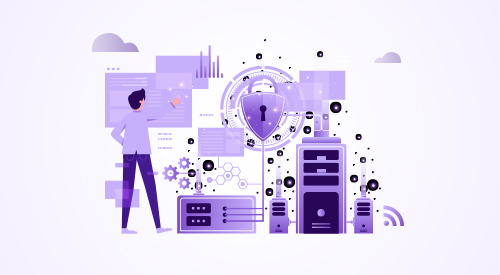

With cloud computing taking over the world and becoming the fastest growing technology, there are certain security measures to be taken into account. The on-cloud businesses of today need to be well-versed in data-driven cloud security solutions to keep up with the constantly evolving landscape of threats and vulnerabilities. These solutions allow you to secure your company’s information efficiently, scale your services quickly, and effectively mitigate risk. Here we will look at Google Cloud security best practices to be implemented in the organization.
Secure Your Assets On The Cloud
GCP Security Protocols
Here are some of Google Cloud security best practices in place at GCP
Data Autonomy: As a GCP partner, we take data privacy and security seriously. To help our customers protect their business data, we leverage a number of GCP-provided security controls, including access transparency, access approval, shielded VMs, and confidential computing. With these tools, you can review and approve Google access to your customer data, create and deploy hardened workloads that are designed to comply with global privacy standards and protect data privacy throughout the data lifecycle by using strong encryption.
Vulnerability Management: As part of Google Cloud security solutions, GCP’s internal vulnerability management process actively scans for security threats across all technology stacks. This process uses a combination of commercial, open source, and purpose-built in-house tools, and includes quality assurance processes, software security reviews, intensive automated and manual penetration efforts, including extensive red team exercises, external audits. The vulnerability management tracks and follows up on vulnerabilities. In order for security to improve, issues must be fully addressed; therefore, automation pipelines continuously reassess the state of a vulnerability, verifies patches, and flags incorrect or partial resolution. In order to help improve detection capabilities, the focus is on high-quality indicators that separate noise from signals that indicate real threats.
Malware Prevention: Your security organization will change how it operates both with a new collaborator in the cloud and from within. While every organization is different, Google has identified some typical changes to security roles and responsibilities that you can expect during your transformation to the cloud.
Monitoring: Among the array of Google Cloud security products, Google Cloud offers two powerful tools for monitoring and responding to malware – Chronicle and VirusTotal. Chronicle is a team of threat researchers who develop threat intelligence for use with Google Cloud. VirusTotal is an online service that analyzes files and URLs to identify viruses, worms, trojans, and other malicious content that’s detected by antivirus engines and website scanners. The cloud security system also helps you detect and mitigate the impact of ransomware, which is a disruptive form of malware that combines digital extortion with other malicious
Incident Monitoring: GCP takes cloud environment security very seriously. The cloud has a comprehensive incident-management process in place to deal with any potential events that could threaten the confidentiality, integrity, or availability of systems or data. Their security incident-management program is modeled after the NIST guidance on handling incidents.
The basic do’s and don’ts of cloud security
- Avoid assuming that the existing control implementations are effective. Instead ensure regular review of control objectives for implementation.
- Avoid assuming that the existing processes, such as centralized processes, will fit the cloud. Instead enable your teams to implement flexible cloud processes rather than finding workarounds to existing processes.
- Avoid using on-premises models, such as a virtual security appliance for security controls in the cloud. Instead use cloud-native approaches, including log monitoring and access management.
- Avoid reliance on historical approaches to ensuring compliance with policies and standards. Rather, begin adopting data-driven approaches to achieve the scale and velocity needed for continuous controls monitoring.
Top 5 Google Cloud security best practices to implement
Here are our suggested top 5 Google Cloud security best practices for a secure cloud environment
- Adopt a zero-trust philosophy: Traditional security approaches focus on hardening a secure perimeter and keeping threats outside of that perimeter. However, this model can lead to under-investment in configuring and securing internal applications and infrastructure, and does not reflect the realities of modern security threats. Cloud security—really all modern security—means thinking differently because perimeters in modern information ecosystems are not well defined and not easily secured through traditional means. The perimeter model is no longer an effective security measure for data in the age of the cloud. With a zero trust philosophy, every piece of data and operation is verified, regardless of location. This philosophy makes information more secure against modern threats and allows for more flexible design of information systems.
- Risk-informed security: Cloud security also lets you think differently about risk. Traditional security approaches often take a risk-averse approach, cautiously avoiding threats, especially threats that existing security infrastructure cannot mitigate. However, in the current security environment, new threats are continuously emerging, your surface area is constantly increasing, and many threats are unavoidable. Cloud security recognizes that these unavoidable threats exist and takes a risk-informed approach to securing your information. With risk-informed security, you analyze and assess risks, and then manage them in a way that takes those risks into account. For example, you can develop a risk taxonomy that categorizes the risks that most concern you and your company, then map the risks in your taxonomy to the controls for mitigating those risks. This approach lets you address the most important security risks, rather than only those risks that you already know how to mitigate.
- Security at scale: Traditional security approaches have been known to limit the size of systems they are meant to protect. The reason for this is typically because smaller and simpler systems are less exposed to threats and risks. However, with cloud security, which is scalable and data driven, you can rethink these assumptions. Cloud security enables you to scale your systems to millions of users and petabytes of secure data. For example, you can manage Identity and Access Management (IAM) at a massive scale by using secure services that have been developed by cloud service providers. Traditional security approaches can also limit the scope of security controls. For example, manual review can lead to sample-based assurance models instead of complete security coverage. Cloud security can offer greater breadth of security coverage and greater flexibility by using data-driven approaches to secure assets.
- Evolve key security roles and responsibilities: When you move to the cloud, it changes more than just where your data is stored. It also affects how your security team works. For example, you’ll need to automate security tasks that were once manual, and create new roles and responsibilities as needed. You’ll also need to work more closely with developers, and partner with cloud service providers. As with any organizational change, it’s important to communicate these changes clearly and help your team members adapt smoothly to the new way of working.
- Leverage cloud service providers: One of the benefits of cloud transformation is that your cloud service providers become crucial partners. In addition to developing security and monitoring tools and documenting cloud best practices, your cloud service providers take on many key security responsibilities for your organization. This can free up your resources to focus on other areas of your business.
There are a lot of options to choose from when it comes to cloud security, and we want to make sure that you are taking advantage of the best ones. Leverage the best of the cloud with the right moves.











